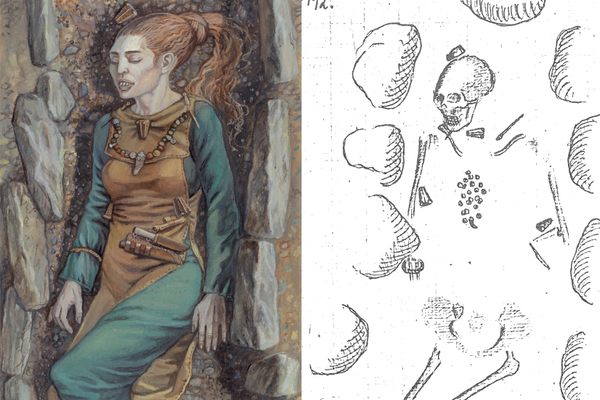Found: A Second North American Settlement That Was Likely Vikings
Satellite imagery led archeologists to a site that shows Viking-like activity.

An artist imagines Vikings crossing the ocean. (Image: Jens Erik Carl Rasmussen/Public domain)
Until 1960, when archaeologists first visited L’Anse aux Meadows, on the tip of Newfoundland, Viking journeys to North America were no more than legends. Finding this one small site and, after years of excavations, a few definitive pieces of evidence made those stories true. Vikings had made it all the way across the Atlantic to at least this one place.
Since then, there have been no more Viking sites found in North America. Now, though, Sarah Parcak, who’s quickly becoming famous for her “space archeology,” may have found a second.
Parcak uses satellite imagery to discover previously unknown archeological sites. Most of her work has been done in Egypt, but recently she and her collaborators began examining satellite imagery of North America’s eastern coast to see what they might find. From hundreds of “hot spots” identified as intriguing possibilities, one site was particularly exciting: it showed the strongest hints that humans may have once built something there.
Over the summer, Parcak and her colleagues conducted a “test excavation” of the site, and they found evidence of human activity—hearth traces of charcoal and 28 pounds of slag, National Geographic reports, along with a turf wall. (The National Geographic Society helped support the excavation; Parcak also worked with the science series NOVA, which made a documentary of the excavation.) The hearth looked to be an iron-working site. The only other pre-Columbian iron-working site in North America was found at L’Anse aux Meadows.
It’s not certain yet that this new site was inhabited by Vikings. It’s yet to be dated, and there’s no piece of evidence that shows definitively that Vikings were here.
There are just tantalizing clues. Other people who lived in Newfoundland did not make turf walls like the one the archeologists found. Vikings were known to seek out sites with bog iron, and this one has that resource. Though there have been few artifacts found, that’s apparently a good sign: while archeological sites associated with other people living in North America tend to have pottery and other longer-lasting artifacts associated with them, Viking objects, made of wood, tend to have disappeared, leaving sites with little detritus.
If this is the second Viking site to be found in North America, it’ll expand the story of their journeys to this side of the ocean. And if there are two Viking sites in North America, the hunt is on for more.
Bonus finds: Ancient glass sponge reef
Every day, we highlight one newly found object, curiosity or wonder. Discover something amazing? Tell us about it! Send your finds to sarah.laskow@atlasobscura.com.










Follow us on Twitter to get the latest on the world's hidden wonders.
Like us on Facebook to get the latest on the world's hidden wonders.
Follow us on Twitter Like us on Facebook